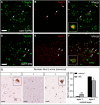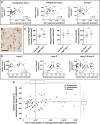A potential protective role of the nuclear receptor-related factor 1 (Nurr1) in multiple sclerosis motor cortex: a neuropathological study
- PMID: 37056475
- PMCID: PMC10088483
- DOI: 10.1093/braincomms/fcad072
A potential protective role of the nuclear receptor-related factor 1 (Nurr1) in multiple sclerosis motor cortex: a neuropathological study
Abstract
Cerebral cortical inflammation and neurodegeneration are hallmark pathological features of multiple sclerosis that contribute to irreversible neurological disability. While the reason for nerve cell death is unknown, the pathogenic inflammatory role of infiltrating lymphocytes is likely an important contributor. The nuclear receptor-related factor 1 counteracts inflammation in animal models of multiple sclerosis, and protects against neuronal loss in other neurodegenerative disorders, but its expression in post-mortem multiple sclerosis tissue is not known. This study aims to investigate the nuclear receptor-related factor 1 expression in multiple sclerosis motor cortex and evaluate its relationship with motor cortical pathology. To accomplish this, an autopsy cohort of pathologically confirmed multiple sclerosis (n = 46), and control (n = 11) cases was used, where the nuclear receptor-related factor 1 expression was related to neuronal and lymphocytic densities. Motor cortical nuclear receptor-related factor 1 was overexpressed in multiple sclerosis compared to control cases. Increased nuclear receptor-related factor 1 expression positively associated with neuronal densities, especially when present in nucleus of neurons, and associated with decreased CD8+ cytotoxic lymphocyte density. Our findings expand the current knowledge on nuclear receptor-related factor 1 in neurological diseases, and support the hypothesis that nuclear receptor-related factor 1 may play a dual neuroprotective role in multiple sclerosis by influencing inflammatory and neurodegenerative processes. Future studies elucidating the influence of nuclear receptor-related factor 1 on these processes in multiple sclerosis may cast light onto novel targets that may be modulated to alter clinical outcome.
Keywords: Nurr1; lymphocyte inflammation; multiple sclerosis; neuronal loss.
© The Author(s) 2023. Published by Oxford University Press on behalf of the Guarantors of Brain.
Conflict of interest statement
The authors report no competing interests.
Figures





Similar articles
-
Cortical neuronal densities and cerebral white matter demyelination in multiple sclerosis: a retrospective study.Lancet Neurol. 2018 Oct;17(10):870-884. doi: 10.1016/S1474-4422(18)30245-X. Epub 2018 Aug 22. Lancet Neurol. 2018. PMID: 30143361 Free PMC article.
-
Neuronal injury in chronic CNS inflammation.Best Pract Res Clin Anaesthesiol. 2010 Dec;24(4):551-62. doi: 10.1016/j.bpa.2010.11.001. Epub 2010 Nov 29. Best Pract Res Clin Anaesthesiol. 2010. PMID: 21619866 Review.
-
Expression of the neuroprotective protein aryl hydrocarbon receptor nuclear translocator 2 correlates with neuronal stress and disability in models of multiple sclerosis.J Neuroinflammation. 2018 Sep 19;15(1):270. doi: 10.1186/s12974-018-1290-6. J Neuroinflammation. 2018. PMID: 30231889 Free PMC article.
-
Meningeal inflammation in multiple sclerosis induces phenotypic changes in cortical microglia that differentially associate with neurodegeneration.Acta Neuropathol. 2021 Jun;141(6):881-899. doi: 10.1007/s00401-021-02293-4. Epub 2021 Mar 29. Acta Neuropathol. 2021. PMID: 33779783 Free PMC article.
-
Molecular Insights into NR4A2(Nurr1): an Emerging Target for Neuroprotective Therapy Against Neuroinflammation and Neuronal Cell Death.Mol Neurobiol. 2019 Aug;56(8):5799-5814. doi: 10.1007/s12035-019-1487-4. Epub 2019 Jan 25. Mol Neurobiol. 2019. PMID: 30684217 Review.
Cited by
-
MicroRNAs dysregulated in multiple sclerosis affect the differentiation of CG-4 cells, an oligodendrocyte progenitor cell line.Front Cell Neurosci. 2024 Feb 29;18:1336439. doi: 10.3389/fncel.2024.1336439. eCollection 2024. Front Cell Neurosci. 2024. PMID: 38486710 Free PMC article.
-
The NR4A2/VGF pathway fuels inflammation-induced neurodegeneration via promoting neuronal glycolysis.J Clin Invest. 2024 Jun 18;134(16):e177692. doi: 10.1172/JCI177692. J Clin Invest. 2024. PMID: 39145444 Free PMC article.
References
-
- Compston A, Coles A. Multiple sclerosis. Lancet. 2008;372(9648):1502–1517. - PubMed
LinkOut - more resources
Full Text Sources
Other Literature Sources
Research Materials
Miscellaneous
